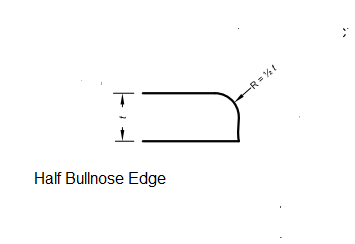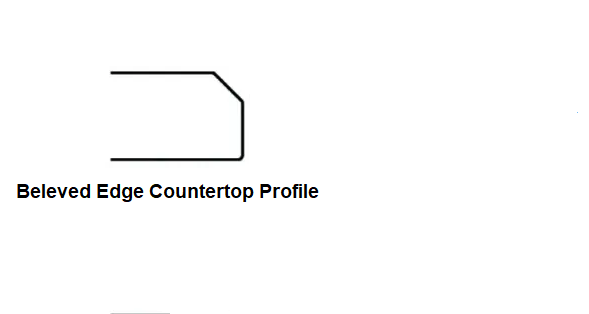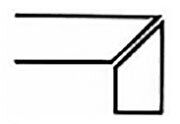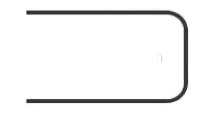13 Top Popular (BEST) Countertop Edge Pictures | Countertop Edge Pros and Cons
13 Top Most Countertop Edge | Countertop Edge Pros and Cons
Countertop Edges
Countertop edges are an overlooked yet important element of every kitchen. They help to protect surfaces from bumps and scrapes, keep spills contained, and add a sleek finish to any design.
In this post, we’ll briefly touch on the different types of countertop edge options available, as well as some factors to consider when choosing which one is right for your project.
Different Types of Countertop Edges With Pictures
Countertop edges come in a variety of finishes, styles, and shapes. Today, there are a number of options that can complement a range of kitchen designs and styles.
Here are some examples:
1. Bullnose Edges Countertop:
Bullnose edge style is similar to the letter “U” laying on its side. A bullnose style may be seen on a countertop that is rounded on both the top and bottom borders.
This form offers the illusion of a thin countertop.
From a safety viewpoint, a bullnose finish is excellent. It doesn’t have many sharp places where you could cut yourself.
Not only that, but the lack of defined angles reduces the likelihood of your countertop material chipping when something strikes it.
Bullnose edges, on the other hand, are difficult to maintain clean.
Because the rounded edge bends all the way around to the underside of the counter, wiping it off with a damp towel may simply result in crumbs being pushed to the underside of the counter.
Water spills may also follow the curve until they reach your wood cabinets.
2. Half Bullnose Edges Countertop:
A half bullnose edge is a countertop edge with a slightly curved top and a flat bottom. This quartz edge offers a countertop a beautiful, curving shape.
This, like a half bevel, will keep spillage from harming the cabinets below. Furthermore, it has the potential to make your countertop appear thicker.
The key advantages of this type of edging include: It prevents water from spilling down the cabinet’s sides and gives your kitchen a nice look.
They do not however have a comparable safety providing as the bullnose kitchen countertop edges. Again, they’re not as kid-friendly as bullnose edges.
3. Beveled Edge Profile Countertops:
Beveled edges are a traditional design that was popular in classical stone buildings. The edge is angled at roughly 45 degrees.
Beveled edges for countertops may be paired with various forms to create a one-of-a-kind and interesting look.
You may also change the bevel’s form and angle. Beveling is used for both aesthetic and practicality.
The beveled edge profile is a remarkable kitchen countertop option for those who want a more modern look. It’s a great alternative to the standard squared edges.
This style of countertop edge works nicely in a variety of kitchens. Beveled edges, for example, complement both modern and rustic kitchens.
Beveled-edged countertops are simpler to clean. Again because of the shape of these borders, if waterfalls on the countertop, it will drop down to the floor rather than directly into your cabinets.
This type of countertop style makes your kitchen look as if it were built-in. However, it does have some disadvantages as well.
Beveled edges are very common, which means they aren’t a major enhancement to a countertop.
4. Ogee Edges Countertops:
Ogee edge is a style of edge with an S curved and is a more upscale countertop edge. Despite its uniqueness, this is a pretty standard edge design with an S-shaped pattern distinguishing feature
This design’s curves can be tight or broad, and the size of the curves has a significant impact on the overall appearance of an ogee edge.
Ogee edges are typically safe around little children; however, they are difficult to clean and might appear “too much” if used throughout your kitchen.
Consider the granite double ogee edge, which is a timeless, traditional edge profile.
There are several varieties of ogee edges, and this design may be very luxurious when carved into a granite countertop or something comparable.
When done correctly, these borders may dramatically improve the look of a space.
When done incorrectly, they might appear gaudy and out of place. Take care when approaching these ledges.
Ogee edging is often used on the tops of cabinets, or around the perimeter of the countertop, and it creates an interesting, non-traditional look. Using ogee can change how much functionality your kitchen has.
5. Mitered Edges Countertops:
A mitered edge produces a smooth edge between the top of the countertop and a second piece of stone, which may be used to create a specialized edge or link a waterfall panel.
The mitered seam enables the design to “wrap” from the horizontal to the vertical surface.
For the stone pattern to stay consistent, the countertop slab material must be carefully cut at a 45-degree angle and correctly installed.
A mitered edge gives the appearance of a thick tabletop. This is accomplished without the price of a solid slab. It complements both classic and modern kitchen designs.
Furthermore, a mitered edge is an excellent method to make your countertops the main point of the room since it quickly creates a rich and costly impression.
Notably, this process may be reversed to build bespoke built-in sinks, cabinets, or other features.
Overall, picking an edge style is a matter of personal preference. As a result, if you favor the designs we’ve mentioned, a mitered edge may be ideal for you.
However, when compared to other countertop edges, mitered edges are more costly.
7. Square Edges Countertop:
A square countertop edge is a simple but effective way to finish your countertop edges
Because they complement most styles, square-edged countertops are the most popular. Square edges complement almost any kind of home, particularly more modern designs.
Square edges are less expensive, easier to maintain clean, and less prone to incur damage than rounded or softened edges.
The edges of most square-edged countertops are softened to minimize the angle sharpness. They can also feature a waterfall that dips.
These two forms of squared edge designs are mostly utilitarian. Extremely sharp edges might cause accidents and be prone to chipping.
The problem with these edges is that they are quite unsafe if you have small children since they are just sharp corners waiting to be run into.
Also, some individuals don’t like these borders because they believe their designs are too minimalist.
8. Straight Edge Countertop:
The straight edge is a square edge that has been gently softened to minimize countertop damage or injury.
A straight edge is not precisely what it purports to be. Straight edge countertops are still somewhat rounded to protect the surface from harm.
This is ideal for individuals seeking for a subtle edge that will not detract from other aspects of your remodel’s design.
9. Quarter Round Edge Countertop:
This countertop option, like the half bullnose, has a rounded edge on the top of the stone, but it is somewhat smaller with a pencil diameter.
This quartz edge offers a sleek appearance that can go well with any decor.
This countertop option will make your stone appear somewhat thicker, making it suitable for both modern and classic designs.
10. Eased Edge Countertop:
An eased edge design is a slightly ‘softened’ square that eliminates the harsh, sharp edge seen on laminate counters.
Despite the fact that the softened edge design does not detract from a tiny kitchen.
In fact, it adds an upmarket touch to small kitchens and complements modern designs that feature thin or strangely shaped countertops and concealed counter extensions that you pull out when you need more work or meal space.
The edges of an eased edge countertop are rounded and square. Some people call it a’softened square’ appearance.
It’s a common laminate countertop edge. A harsh square edge would expose the ugly layers, but a softened edge would cover them. Eased edge and quartz also go nicely together.
11. Pencil Edge Countertops:
The name ‘pencil’ relates to the rounded glass finish of the edge radius, which is comparable in roundness to that of a pencil.
Because glass protector tops fit neatly on them, this kind of edge treatment is perfect for circular tables or furniture with rounded edges.
One significant advantage of pencil edge polish is its safety.
Pencil edges have a little softened edge and are the ideal choice if you have children in the house.
They have a linear design but no sharp corners or edges, so you don’t have to worry about someone getting harmed if they run into it.
12. Waterfall Edge Countertop:
Waterfall edge is a modern style that has a countertop that falls from the top to the floor like a waterfall, as the name indicates.
This allows the countertop to be extended downwards, with the slab extending from the countertop down the side and to the floor for a flowing look.
A waterfall edge is a design feature that creates a 90-degree curve at the end of a countertop.
Rather than merely terminating with a completed edge, the countertop extends along the side of the cabinet, island, or seating area.
This is an excellent pick for a modern or contemporary room, especially if you’re crazy about stone.
13. Crescent Edge Countertop:
A crescent edge is a laminate countertop edge that resembles bullnose edges but has a less dramatic curve.
It is a soft curving shape that is similar to the classic Bullnose edge but has a little more sharp appearance.
The style simplicity is appealing, and it blends nicely with more current design schemes. Any countertop with a crescent edge will look fantastic in this setting.
A crescent edge might be precisely what you’re searching for if you want a fashionable but not overly showy edge.
This edge will look great with your countertop’s stone slab. You can never go wrong with a Crescent edge.
Edge profiles round out the appearance of any countertop. Choosing a Crescent edge for your countertop might be one of the finest decisions you ever make. This edge will round out the look of a countertop that you will love for many years.
Countertop Edges FAQs
1. What are Countertop edges and why are countertop edges important?
Countertop edges are the finishing edge of your countertop. This edge is determined by the installation of the countertop.
Countertop edges are a very important aspect of a countertop as they protect the material from smashing and getting damaged.
If a countertop is going to be exposed to a lot of wear and tear then the edges should be protected to prolong the life of the material.
Sometimes edge protection can be made from a simple miniature shelf that fits along the front edge of the countertop.
This will help protect the countertop from a lot of wear and damage, as it could be from being hit/bumped by a chair or table.
There are also edge pieces that can be inserted inside of cabinet edges which prevent damage from being done to the cabinet by the front of the countertop. These two pieces also protect from getting gashes in wood surfaces
2. What are the different types of countertop edges?
Pencil: Pencil edges are sharp and can be used in most countertop applications. These types of edges provide a smooth edge, and the corners create a distinct aesthetic, which is most ideal for kitchens and bathrooms.
Full Bullnose: As its name suggests, this edge is pretty much a complete curve from one corner to the other, creating a perfect 90-degree angle between top and bottom of the slab.
This profile can give you a totally dramatic look on your countertops by creating flowing lines on your countertops.
Ogee Edges: It is made up of two smooth curves that appears to be a S shape. To get the appropriate edge, the curve can be softened or strengthened.
This countertop edge is common on quartz and granite countertops. They seem elegant and expensive due to their dramatic character.
They give the countertop and cabinetry more depth. This design is typically utilized in bigger kitchens.
Because of the size and distinctiveness of the edge, this countertop edge design is an important component of the entire design.
Beveled Edges: The beveled edge is a classical style that was popular in classical stone architecture. The edge is angled at roughly 45 degrees.
Beveled edges for countertops may be paired with various forms to create a one-of-a-kind and interesting look.
You may also change the bevel’s form and angle. Beveling is used for both aesthetic and practical reasons.
Eased edge: An Eased edge design is a slightly ‘softened’ square that eliminates the harsh, sharp edge seen on laminate counters.
Despite the fact that the softened edge design does not detract from a tiny kitchen.
In fact, it adds an upmarket touch to small kitchens and complements modern designs that feature thin or strangely shaped countertops and concealed counter extensions that you pull out when you need more work or meal space.
Chiseled edges. Chiseled edges provide a rustic touch to your kitchen by exposing raw stone for a more natural appearance.
Its jagged edges appear wild, giving it the appearance of being a touch “rough around the edges.
Quarter round edge: The top edge of the granite has a small radius with the quarter round edge, roughly the diameter of a pencil.
This provides the countertop edge a sleek appearance that pairs well with a classic design.
3. Can I cut the edge of my countertop?
Yes, you can cut the edge of your countertop with a grinder or diamond-edged knife (must be authorized by your state).
You don’t want to damage your surface, but if you cut it too much during installation, everything will be fine again when you take off.
4. What edge is best for quartz countertops?
The full bullnose is one of the most frequent edges for your quartz countertop and is a popular choice among homeowners.
It has a complete curve on both corners, resulting in a smooth corner all the way around. This classic design is unquestionably ideal for any kitchen or bathroom countertop.
5. What type of countertop edge is best?
If you are thinking about the type of edge that will be best for your countertop, you should consider various things.
For example, what kind of sink will you put in your kitchen? If it’s not a standard size, then you can choose an edge that is customized to create an ideal countertop for your kitchen.
Other than that, the amount you would like to save is another important consideration. You can save money by cutting or rounding off this detail yourself.
6. What is the difference between pencil edge vs eased edge?
Pencil edges have a little softened edge and are the ideal choice if you have children in the house. They have a linear design but no sharp corners or edges, so you don’t have to worry about someone getting harmed if they run into it.
Eased edges, on the other hand, are just gently rounded corners on a square end that aid in the removal of any sharp edges that are prone to chipping.
These are more durable than conventional squared edges, since the rounded surface lowers the odds you would chip them if you were to strike them on the edge with a harsh object.
7. What is a mitered edge countertop?
A mitered edge provides a smoother edge between the top of the countertop and a second piece of stone, which may be used to create a specialized edge or to link a waterfall panel.
For the stone pattern to stay consistent, the countertop slab material must be carefully cut at a 45-degree angle and correctly installed.
8. What is a beveled edge countertop?
A bevel edge is a classic edge design in which the countertop’s top corner is cut at a 45-degree angle. A bevel edge is distinguished by a slight, angular edge.
This is a beautiful countertop alternative that adds a little additional style without cost, making a countertop seem less crisp and more sophisticated.
This countertop edge also prevents spilt water from harming the counters below – an important feature if you anticipate accidents!
Bevel is a basic, traditional, and beautiful granite or quartz edge profile. This look works equally well on modern countertops as it does in a vintage kitchen in need of a facelift.
9. What is a half-round edge countertop?
Half-round slabs have a curved edge that starts from halfway between two corners and ends just after the center of the slab.
10. What is a Dupont edge countertop?
The top of the Dupont edge has a strong 90-degree angle that dips down and merges into a bullnose-edge curvature. It is a more daring choice than an Ogee edge, yet it works well in a classic kitchen.
11. What is the difference between mitered edge vs eased edge?
Mitered edges are extremely similar to square edges, yet they differ sufficiently to have their own set of advantages and disadvantages.
A mitered edge is formed when the corners of two slabs are cut at a 45-degree angle to connect them together smoothly.
This sort of edge is useful when you want the look of a thicker countertop, waterfall island, or custom trough sink.
What you’re looking at is most likely a mitered edge that was expertly constructed to appear as though the veining “wraps” around the edges for a seamless appearance.
Furthermore, a mitered edge is an excellent method to make your countertops the main point of the room since it quickly creates a rich and costly impression.
In contract, the edges of an eased edge countertop are rounded and square.
Some people call it a ‘softened square’ appearance. An eased edge countertop is not only visually attractive, but it is also very safe.
If you’re concerned about a tiny child (or yourself) slamming into a sharp countertop edge, this will help.
It’s also one of the most common laminate countertop edges. A harsh square edge would expose the ugly layers, but a softened edge would cover them. Eased edge and quartz also go nicely together.
12. What is a double pencil edge countertop?
The Double Pencil edge has somewhat more rounded corners than the Flat Polish edge, but it still has a sleek and modern vibe.
Such an edge is frequently selected for its smooth, pleasant feel, especially in a casual setting where people are leaning on the counter or sitting at a breakfast bar.
13. What are the advantages of granite countertops over other types of countertops?
Granite is a hard, yet still soft stone. It has a distinctive texture that is similar to slate, but it is harder.
It has a minimal shading effect, which means it won’t make your kitchen look darker or too different from other kitchens. You can find it in many colors, including white, brown, green, black and pink.
Granite doesn’t stain easily and will not be affected by grease or chemicals.
The color of the granite is uniform and it looks great with any color stone.
Unlike other stones, granite can be cut very precisely and counters should not be larger than 2 inches.
Granite is also environmentally friendly and does not allow for disease growth.








